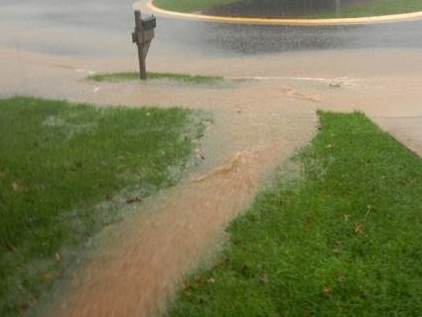 The following approaches to redirect and capture runoff can be used to control heavy runoff causing prolonged wet areas or yard erosion.
The following approaches to redirect and capture runoff can be used to control heavy runoff causing prolonged wet areas or yard erosion.
If you have heavy runoff from roof downspouts and neighboring properties, redirecting or capturing runoff can provide better control. These techniques will minimize the amount of water that accumulates or that causes erosion in the problem area. Many of the practices described below can be used in tandem: for example, you can safely redirect runoff and then capture it and allow it to soak into the soil.
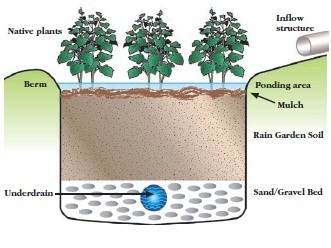 Capture and Store Runoff
Capture and Store Runoff
Runoff can be captured and stored for use or allowed to soak into the soil. Rain barrels and cisterns are used for storage. Dry wells, soil amendment and rain gardens are used to infiltrate water into the soil.
These solutions have many environmental benefits: reducing runoff from your property, filtering runoff, watering your yard and recharging groundwater. They can also be combined with structures that redirect runoff. For instance, a grassy swale or downspout extension can be built to deliver runoff to a dry well or rain garden.
However, these practices may not be appropriate for every location.
- Rain gardens or dry wells should not be located next to the foundation of the home to avoid water problems in the basement or foundation.
- If your soil has a poor infiltration rate, an underdrain may need to be included in the design of a rain garden or dry well. Soil with high groundwater or very shallow depths to bedrock are also problematic. Find your soil type using Soil Survey maps. Before installing a rain garden or dry well, you should also do an infiltration test.
If more than 2500 square feet will be disturbed in constructing one of these practices, you will need a permit in Fairfax County. See: Site-Related Plans. In other jurisdictions, refer to local codes and ordinances.
1. Rain Barrel or Cistern
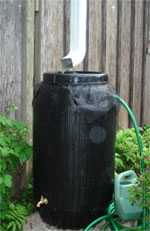 A rain barrel is a large container that attaches to the end of a downspout and stores water for later use, such as watering your garden or lawn. Rain barrels come in many shapes and sizes. A typical rain barrel holds about 50 gallons of water. Larger cisterns can hold hundreds or even thousands of gallons. Rain barrels are simple to install and inexpensive. Unless you have a cistern, this option generally does not provide enough storage capacity to greatly reduce the amount of runoff flowing to the lawn during large storms. Rather, rain barrels are most useful as an addition to other stormwater controls.
A rain barrel is a large container that attaches to the end of a downspout and stores water for later use, such as watering your garden or lawn. Rain barrels come in many shapes and sizes. A typical rain barrel holds about 50 gallons of water. Larger cisterns can hold hundreds or even thousands of gallons. Rain barrels are simple to install and inexpensive. Unless you have a cistern, this option generally does not provide enough storage capacity to greatly reduce the amount of runoff flowing to the lawn during large storms. Rather, rain barrels are most useful as an addition to other stormwater controls.
- An overflow device allows excess water to escape when the barrel or cistern is full. Use corrugated plastic tubing to direct overflow away from the foundation of your home.
- A downspout can be connected to one or more rain barrel(s). Connecting rain barrels increases the amount of runoff that can be captured.
- For more information, see: Rain Barrel Workshops
2. Rain Garden
 A rain garden is a heavily planted landscaped depression situated in the path of runoff flow, with permeable soil. During storms, runoff will pool on the surface of the rain garden and soak into the soil, filtering the water and recharging groundwater.
A rain garden is a heavily planted landscaped depression situated in the path of runoff flow, with permeable soil. During storms, runoff will pool on the surface of the rain garden and soak into the soil, filtering the water and recharging groundwater.
The proper functioning of a rain garden depends on the permeability of the natural soil. In the absence of adequate permeability, an underdrain may be needed to allow filtered water to be discharged, which can add to the expense and time of construction.
In the rain garden, the natural soil is amended or replaced with a mixture of sand, topsoil and organic compost (or a pre-made rain garden mix). The depth of these amendments can vary depending on the effort and resources that you wish to commit, but eighteen inches should be considered a minimum. Underneath the amended soil, an optional gravel or sand bed stores stormwater so that it may soak into the underlying natural soil.
Rain gardens can be a good solution to large, widespread drainage problems in a backyard. They can come in many styles and sizes. Larger and deeper rain gardens will treat more runoff, smaller and shallower rain gardens will treat less, but all properly functioning rain gardens will reduce polluted stormwater and help to recharge groundwater.
More information and instructions for designing and building a backyard rain garden are available from NVSWCD's Rain Garden Design and Construction: A Guide for Homeowners or the Seven Myths about Rain Gardens article.
3. Soil Amendment or Compost Blanket
Often urban and suburban soil is dense, compacted and has low fertility. Adding organic matter or compost to the soil reduces soil density and improves soil structure. Structure refers to the clumping together of soil particles. Soil with good structure is more porous, promoting infiltration and reducing runoff. Soil amendment also improves the health and productivity of your soil by adding a long-term source of nutrients and organic matter. There are two general approaches.
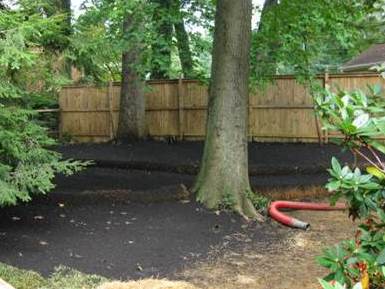 Low intensity method:
Low intensity method:
Compost blanket. Put down a thin layer of compost and rake it in to your lawn, making sure that you do not bury your grass or other existing vegetation. If you are applying compost to a bare spot or un-vegetated section of your property, you may add a thicker layer.
What should you use for compost? You can purchase compost commercially, although you can also use leaf mulch. There are pick-up sites across the county for free leaf mulch. For an even simpler approach, you can recycle the organic matter you have on site by leaving grass clippings on the lawn (grass-cycling) and mowing your fall leaves into your lawn instead of bagging them. The clippings and mowed leaves will break down on their own and become compost in the soil. It may take a few seasons to see noticeable change in your soil.
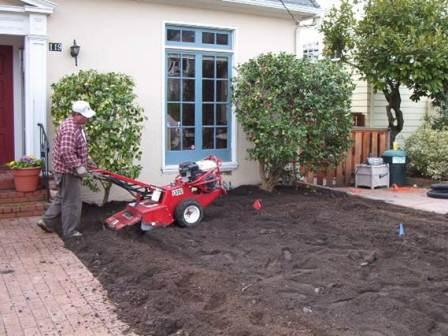 High intensity method:
High intensity method:
Soil Amendment. Think of a farmer plowing a field. Heavy-duty soil amending is basically the same thing. Instead of adding seeds, you will be mixing compost into your soil. This option is more costly and more intense (you’ll have to tear up your lawn!) but the results will be immediate and noticeable.
First, choose the area of your property that you wish to amend. Based on that area, you can calculate how much compost you’ll need. There is no set rule, but if you are going to use the more intense method, we recommend using at least four inches, if not more. You can either hire a landscaper or rent a rototiller or small backhoe. Till down 10 inches to two feet to mix in your compost. You can purchase compost commercially, or you can also get leaf mulch from the county for free. Be aware that the free leaf mulch from the county is not always of consistent quality, will not be fully decomposed and may contain weed seeds. Replant with your preferred vegetation immediately.
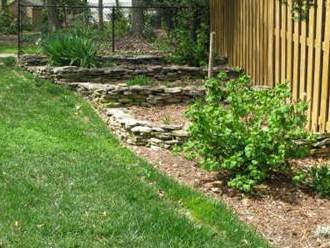 Terraces can often be backfilled with soil amendment to slow down runoff and also improve infiltration. For more information, see: How to Protect Eroding Land - Terraces
Terraces can often be backfilled with soil amendment to slow down runoff and also improve infiltration. For more information, see: How to Protect Eroding Land - Terraces
4. Dry Well (Infiltration Trench)
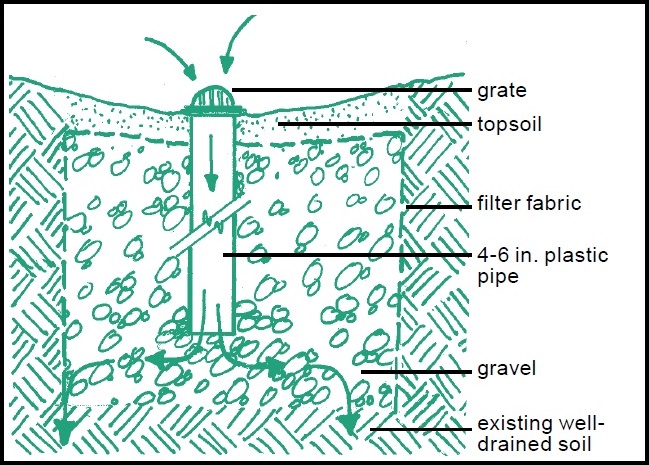 A dry well or infiltration trench is a gravel-filled underground storage area. Water captured by a dry well is stored in the void spaces between the gravel until it infiltrates slowly into the ground or flows out through an underdrain.
A dry well or infiltration trench is a gravel-filled underground storage area. Water captured by a dry well is stored in the void spaces between the gravel until it infiltrates slowly into the ground or flows out through an underdrain.
- The sides of the dry well (not the bottom) are lined with landscape fabric.
- Water can be directed to a dry well from a downspout or other pipe.
- It may be used as a walkway or covered with topsoil and sod.
- It is best to excavate until a permeable soil layer is found. A dry well is only a good option if a permeable layer of soil is found within a reasonable depth. If no such layer exists, a dry well might not be a good solution.
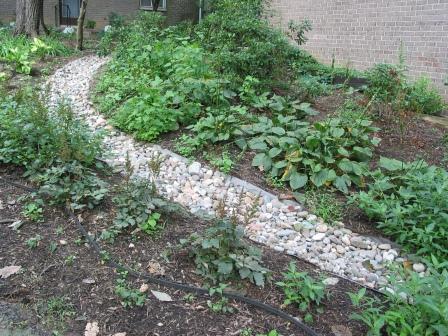 Redirect Runoff
Redirect Runoff
Intercepting and redirecting runoff provides an opportunity to safely discharge the volume to a place beyond the problem area. This can be done using swales, French drains, catch basins or downspout and sump pump extensions. These methods of rerouting can be combined together with capture and storage practices (see below).
Whenever you are redirecting runoff, you must send it to a suitable outlet. Discharging runoff to an unsuitable area will just move the problems downhill. Be aware that redirecting runoff without soaking it into the soil can negatively impact neighboring properties.
1. Swale
A swale is a wide, shallow ditch in which water can flow to a suitable outlet. The channel should be protected with grass or other vegetation. It also can be lined with appropriately sized stone to prevent erosion within the swale.
Stone is preferable in swales in which grass does not grow well due to shade or that are too steep or long for grass to prevent erosion. A swale lined with stone is sometimes called a dry creek bed. Stones used can be of varying sizes, with larger ones acting as stabilizers and smaller ones as fillers. Generally, the heavier the flows the larger the stones should be. Tightly woven landscape fabric should be placed below the stone lining.
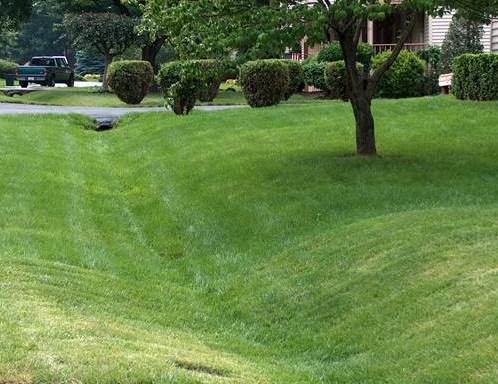

2. French Drain
A French drain is an underground drainage device. It consists of a perforated pipe surrounded by gravel and lined with sturdy landscape fabric. A French drain conveys runoff underground to a suitable outlet. Downspout pipes and sump pump pipes can be connected to it, and a catch basin can be combined with it to help remove standing water. Deeper French drains can also be used to drain groundwater.
Tips for building a French drain. Pre-assembled French drain options (such as EZ-Drain) can save time and effort in installation.
- Dig out a ditch where your French drain will go. A standard French drain ditch is about 1.5 feet deep and 10-12 inches wide, varying based on the size of the pipe chosen (usually 4-6 inches) and the desired depth.
- Line the ditch on all sides with landscape fabric to prevent soil erosion.
- Place a layer of gravel at the bottom of the ditch.
- A perforated plastic pipe is laid on top of the gravel and surrounded by gravel on the sides and top.
- If topsoil and sod will be used to cover the French drain, the landscape fabric should be pulled over the top of the gravel before adding the topsoil.
- If the gravel will be left exposed at the ground surface, the landscape fabric does not need to be pulled over the top of the gravel, but the edges should be protected to prevent sediment from entering the French drain.
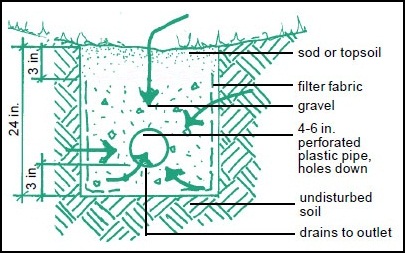
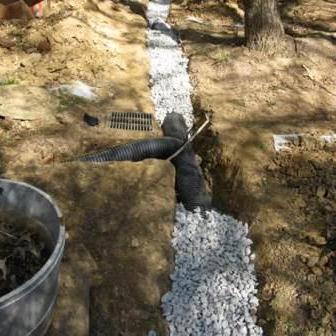
3. Catch Basin
A catch basin is a collection box with a slotted drain at the top and a drainage outlet at the bottom. Surface runoff enters the inlet, passes through the collection box and exits through the outlet into a buried drainpipe. The catch basin should be placed at a low spot on the property so that water naturally runs to it (a grassy swale can be built to direct runoff to the basin). The buried drainpipe should discharge to a suitable outlet.
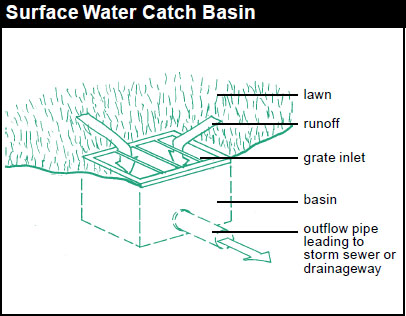
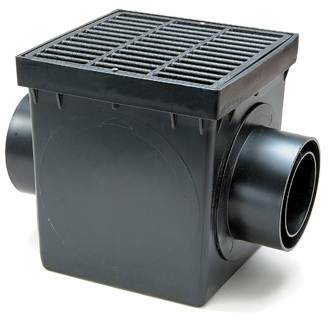
4. Splash Blocks and Downspout Extensions
Splash blocks and corrugated plastic pipe also can be used to direct roof runoff from downspouts or sump pumps away from foundation walls to a suitable area. See: Splash Blocks and Downspouts

